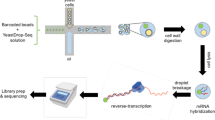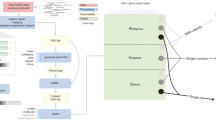Abstract
We present single-molecule sequencing digital gene expression (smsDGE), a high-throughput, amplification-free method for accurate quantification of the full range of cellular polyadenylated RNA transcripts using a Helicos Genetic Analysis system. smsDGE involves a reverse-transcription and polyA-tailing sample preparation procedure followed by sequencing that generates a single read per transcript. We applied smsDGE to the transcriptome of Saccharomyces cerevisiae strain DBY746, using 6 of the available 50 channels in a single sequencing run, yielding on average 12 million aligned reads per channel. Using spiked-in RNA, accurate quantitative measurements were obtained over four orders of magnitude. High correlation was demonstrated across independent flow-cell channels, instrument runs and sample preparations. Transcript counting in smsDGE is highly efficient due to the representation of each transcript molecule by a single read. This efficiency, coupled with the high throughput enabled by the single-molecule sequencing platform, provides an alternative method for expression profiling.
This is a preview of subscription content, access via your institution
Access options
Subscribe to this journal
Receive 12 print issues and online access
$209.00 per year
only $17.42 per issue
Buy this article
- Purchase on Springer Link
- Instant access to full article PDF
Prices may be subject to local taxes which are calculated during checkout






Similar content being viewed by others
Accession codes
References
Lockhart, D.J. & Winzeler, E.A. Genomics, gene expression and DNA arrays. Nature 405, 827–836 (2000).
Churchill, G.A. Fundamentals of experimental design for cDNA microarrays. Nat. Genet. 32 Suppl, 490–495 (2002).
Velculescu, V.E., Zhang, L., Vogelstein, B. & Kinzler, K.W. Serial analysis of gene expression. Science 270, 484–487 (1995).
Brenner, S. et al. Gene expression analysis by massively parallel signature sequencing (MPSS) on microbead arrays. Nat. Biotechnol. 18, 630–634 (2000).
Saha, S. et al. Using the transcriptome to annotate the genome. Nat. Biotechnol. 20, 508–512 (2002).
Shiraki, T. et al. Cap analysis gene expression for high-throughput analysis of transcriptional starting point and identification of promoter usage. Proc. Natl. Acad. Sci. USA 100, 15776–15781 (2003).
Hashimoto, S. et al. 5′-end SAGE for the analysis of transcriptional start sites. Nat. Biotechnol. 22, 1146–1149 (2004).
Kim, J.B. et al. Polony multiplex analysis of gene expression (PMAGE) in mouse hypertrophic cardiomyopathy. Science 316, 1481–1484 (2007).
Chen, J. & Rattray, M. Analysis of tag-position bias in MPSS technology. BMC Genomics 7, 77 (2006).
Siddiqui, A.S. et al. Sequence biases in large scale gene expression profiling data. Nucleic Acids Res. 34, e83 (2006).
Gilchrist, M.A., Qin, H. & Zaretzki, R. Modeling SAGE tag formation and its effects on data interpretation within a Bayesian framework. BMC Bioinformatics 8, 403 (2007).
Hene, L. et al. Deep analysis of cellular transcriptomes - LongSAGE versus classic MPSS. BMC Genomics 8, 333 (2007).
So, A.P., Turner, R.F. & Haynes, C.A. Minimizing loss of sequence information in SAGE ditags by modulating the temperature dependent 3′ → 5′ exonuclease activity of DNA polymerases on 3′-terminal isoheptyl amino groups. Biotechnol. Bioeng. 94, 54–65 (2006).
Nagalakshmi, U. et al. The transcriptional landscape of the yeast genome defined by RNA sequencing. Science 320, 1344–1349 (2008).
Mortazavi, A., Williams, B.A., McCue, K., Schaeffer, L. & Wold, B. Mapping and quantifying mammalian transcriptomes by RNA-Seq. Nat. Methods 5, 621–628 (2008).
Cloonan, N. et al. Stem cell transcriptome profiling via massive-scale mRNA sequencing. Nat. Methods 5, 613–619 (2008).
Oshlack, A. & Wakefield, M.J. Transcript length bias in RNA-seq data confounds systems biology. Biol. Direct 4, 14 (2009).
Harris, T.D. et al. Single-molecule DNA sequencing of a viral genome. Science 320, 106–109 (2008).
Bowers, J. et al. Novel virtual terminator nucleotides for next generation DNA sequencing. Nat. Methods (in the press).
Fisk, D.G. et al. Saccharomyces cerevisiae S288C genome annotation: a working hypothesis. Yeast 23, 857–865 (2006).
Zhang, Z. & Dietrich, F.S. Mapping of transcription start sites in Saccharomyces cerevisiae using 5′ SAGE. Nucleic Acids Res. 33, 2838–2851 (2005).
Miura, F. et al. A large-scale full-length cDNA analysis to explore the budding yeast transcriptome. Proc. Natl. Acad. Sci. USA 103, 17846–17851 (2006).
Kent, W.J. et al. The human genome browser at UCSC. Genome Res. 12, 996–1006 (2002).
Juneau, K., Palm, C., Miranda, M. & Davis, R.W. High-density yeast-tiling array reveals previously undiscovered introns and extensive regulation of meiotic splicing. Proc. Natl. Acad. Sci. USA 104, 1522–1527 (2007).
Holstege, F.C. et al. Dissecting the regulatory circuitry of a eukaryotic genome. Cell 95, 717–728 (1998).
Acknowledgements
We thank all of the past and present colleagues at Helicos who have contributed to this work.
Author information
Authors and Affiliations
Corresponding author
Ethics declarations
Competing interests
All of the authors are or have been employees of Helicos Biosciences.
Supplementary information
Supplementary Text and Figures
Supplementary Figures 1–3, Supplementary Tables 4 and 6, and Supplementary Methods (PDF 369 kb)
Supplementary Table 1
Transcript counts (XLS 1784 kb)
Supplementary Table 2
qPCR measurements (XLS 25 kb)
Supplementary Table 3
Detected sequence variants (XLS 498 kb)
Supplementary Table 5
Coverage peaks in yeast genome. (XLS 106 kb)
Rights and permissions
About this article
Cite this article
Lipson, D., Raz, T., Kieu, A. et al. Quantification of the yeast transcriptome by single-molecule sequencing. Nat Biotechnol 27, 652–658 (2009). https://doi.org/10.1038/nbt.1551
Received:
Accepted:
Published:
Issue Date:
DOI: https://doi.org/10.1038/nbt.1551
This article is cited by
-
RNAseq analysis of treatment-dependent signaling changes during inflammation in a mouse cutaneous wound healing model
BMC Genomics (2021)
-
Single-molecule real-time sequencing facilitates the analysis of transcripts and splice isoforms of anthers in Chinese cabbage (Brassica rapa L. ssp. pekinensis)
BMC Plant Biology (2019)
-
Promoter-dependent nuclear RNA degradation ensures cell cycle-specific gene expression
Communications Biology (2019)
-
Transcriptome profiling of mouse samples using nanopore sequencing of cDNA and RNA molecules
Scientific Reports (2019)
-
Highly parallel direct RNA sequencing on an array of nanopores
Nature Methods (2018)



